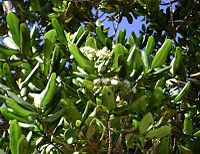Pimenta racemosa
| Pimenta racemosa | |
|---|---|

| |

| |
| Scientific classification | |
| Kingdom: | Plantae |
| Clade: | Tracheophytes |
| Clade: | Angiosperms |
| Clade: | Eudicots |
| Clade: | Rosids |
| Order: | Myrtales |
| Family: | Myrtaceae |
| Genus: | Pimenta |
| Species: | P. racemosa
|
| Binomial name | |
| Pimenta racemosa (Mill.) J.W.Moore
| |
| Synonyms[2] | |
|
List
| |
Pimenta racemosa is a species of plant in the myrtle family (Myrtaceae) that is native to the Caribbean region. Common names include West Indian bay tree,[3] bay rum tree,[3] and ciliment.
Uses
[edit]It is used in cooking and an essential oil is distilled to produce a fragrant cologne called bay rum; although the name is similar to names of flavored alcoholic beverages, the concentrated essential oil from the fruit is toxic and renders the product undrinkable.[4] The leaves are also used for herbal teas.[further explanation needed]
Anti-inflammatory and antinociceptive properties
[edit]Extracts from multiple varieties of Pimenta racemosa display anti-inflammatory properties. These properties are mediated in part by terpenes such as abietic acid and lupeol, which alter neutrophil migration into inflamed regions.[5][6]
Pimenta racemosa also demonstrates antinociceptive properties and has historically been used as an analgesic in the Caribbean.[7]
Description
[edit]The tree is 4–12 m tall and the white flowers, about 10 mm wide, become black, oval fruits measuring 7–12 mm.[8] The ideal conditions for P. racemosa are regular irrigation and bright sunshine.
Ecology
[edit]Pimenta racemosa is widely introduced and can become an invasive weed.[8][9] The plants are now grown widely in other tropical areas, including Oceania.
References
[edit]- ^ IUCN SSC Global Tree Specialist Group; Botanic Gardens Conservation International (BGCI) (2022). "Pimenta racemosa". IUCN Red List of Threatened Species. 2022: e.T62783A208346431. doi:10.2305/IUCN.UK.2022-1.RLTS.T62783A208346431.en. Retrieved 7 January 2023.
- ^ "The Plant List: A Working List of all Plant Species".
- ^ a b "Pimenta racemosa". Germplasm Resources Information Network. Agricultural Research Service, United States Department of Agriculture. Retrieved 2012-08-23.
- ^ desert-tropicals.com: West Indian Bay Tree, Bay Rum Tree
- ^ Fernández, MA; Tornos, MP; García, MD; de las Heras, B; Villar, AM; Sáenz, MT (18 February 2010). "Anti-inflammatory activity of abietic acid, a diterpene isolated from Pimenta racemosa var. grissea". Journal of Pharmacy and Pharmacology. 53 (6): 867–872. doi:10.1211/0022357011776027.
- ^ Fernández, A; Álvarez, A; Garcı́a, MD; Sáenz, MT (April 2001). "Anti-inflammatory effect of Pimenta racemosa var. ozua and isolation of the triterpene lupeol". Il Farmaco. 56 (4): 335–338. doi:10.1016/S0014-827X(01)01080-1.
- ^ Garcı́a, MD; Fernández, MA; Alvarez, A; Saenz, MT (March 2004). "Antinociceptive and anti-inflammatory effect of the aqueous extract from leaves of Pimenta racemosa var. ozua (Mirtaceae)". Journal of Ethnopharmacology. 91 (1): 69–73. doi:10.1016/j.jep.2003.11.018.
- ^ a b Pacific Island Ecosystems at Risk (PIER): Myrtaceae: Pimenta racemosa (by J.W.Moore)
- ^ "USDA PLANTS Profile".
External links
[edit]![]() Data related to Pimenta racemosa at Wikispecies
Data related to Pimenta racemosa at Wikispecies
![]() Media related to Pimenta racemosa at Wikimedia Commons
Media related to Pimenta racemosa at Wikimedia Commons
Text is available under the CC BY-SA 4.0 license; additional terms may apply.
Images, videos and audio are available under their respective licenses.



